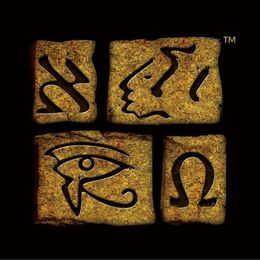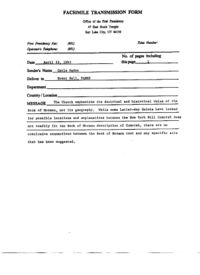
FAIR is a non-profit organization dedicated to providing well-documented answers to criticisms of the doctrine, practice, and history of The Church of Jesus Christ of Latter-day Saints.

Many Latter-day Saints (including apostles and members of the 1st Presidency) have expressed opinions about the location of Cumorah (or other Book of Mormon geography issues), the Church has no official geography for the Book of Mormon.
According to the Church, no revelatory basis exists for any geographical scheme outside of the Book of Mormon text itself.
In 1990, F. Michael Watson (secretary to the First Presidency) sent a letter to a questioner which read as follows:
Two statements made available within the next three years addressed this issue, suggesting that those who use the above letter as proof that the Church officially supports a given geography are mistaken.
The first statement is found in the publication of the Encyclopedia of Mormonism. Although not an official statement of Church policy, two members of the Quorum of the Twelve, Elders Oaks and Maxwell, served as advisers during the production of the Encyclopedia. Thus, we have the following statement published in 1992:
In 1928 the Church purchased the western New York hill and in 1935 erected a monument recognizing the visit of the angel Moroni (see Angel Moroni Statue). A visitors center was later built at the base of the hill. Each summer since 1937, the Church has staged the Cumorah Pageant at this site. Entitled America's Witness for Christ, it depicts important events from Book of Mormon history. This annual pageant has reinforced the common assumption that Moroni buried the plates of Mormon in the same hill where his father had buried the other plates, thus equating this New York hill with the Book of Mormon Cumorah. Because the New York site does not readily fit the Book of Mormon description of Book of Mormon geography, some Latter-day Saints have looked for other possible explanations and locations, including Mesoamerica. Although some have identified possible sites that may seem to fit better (Palmer), there are no conclusive connections between the Book of Mormon text and any specific site that has been suggested.
—David A. Palmer, "Cumorah" in Daniel H. Ludlow, ed., Encyclopedia of Mormonism.
Some have said that this statement is only meant to communicate that there are some members who differ with the Church's leaders and official views.
This seems unlikely--the author of the article, David Palmer, cited one of his papers as evidence ("(Palmer") for the idea that there are "possible sites that may seem to fit better." It would be strange if Palmer was writing an article essentially saying, "There's an official position, but I happen to disagree with it." It would be even stranger if Elders Maxwell and Oaks allowed the blatant advocacy of a position at variance with the Church's official stance.
The Secretary to the First Presidency later wrote to FARMS: "there are no conclusive connections between the Book of Mormon text and any specific site"On April 23, 1993, F. Michael Watson provided a letter after a discussion with a FARMS staffer. The text is similar and consistent with what was published in the Encyclopedia of Mormonism the previous year:
(Some have complained that the fax was private and should not be cited--but why would Watson send a private note to FARMS if it was not anticipated that it would be used to answer the questions being put to FARMS? The letter has long been available publicly, since its text was published by FARMS soon after its receipt.) Since the text of this letter was published in the Journal of Book of Mormon Studies, some critics have charged the FARMS authors with either manipulating the Church into sending the letter, or forging the letter text altogether.[2] Matt Roper of the Neal A. Maxwell Institute for Religious Scholarship located a faxed copy of the same statement sent from the Office of the First Presidency, along with its cover page, and sent FAIR a copy with permission to post it, in order to dispel the myth popularized by critics of the Church that FARMS had invented or forged this letter. The 1993 fax was sent by Senior Executive Secretary for the Office of the First Presidency, Carla Ogden, to Brent Hall of FARMS. The text of the fax matches exactly the text reported to have been in the response by Watson as described in the FARMS Review. The cover letter reads as follows:
|
 |
(Phone and numbers have been redacted from these scans; they are otherwise unaltered. The top of the First Presidency's fax had "Apr 23 '93 12:25 PM FIRST PRESIDENCY SLC P.1" in fainter letters applied by the receiving fax, which does not appear on the scan.)
The Church's official history, Saints, tells the story of Joseph's recovery of the plates from the hill near his home. The account does not, however, ever use the label "Cumorah" for the hill. This is an odd omission if the official prophetic stance on the Hill Cumorah is fixed on the New York site.[3]
Since the publication of the Book of Mormon in 1830, members and leaders of The Church of Jesus Christ of Latter-day Saints have expressed numerous opinions about the specific locations of the events discussed in the book. Some believe that the history depicted in the Book of Mormon—with the exception of the events in the Near East—occurred in North America, while others believe that it occurred in Central America or South America. Although Church members continue to discuss such theories today, the Church’s only position is that the events the Book of Mormon describes took place in the ancient Americas. ...
The Church does not take a position on the specific geographic locations of Book of Mormon events in the ancient Americas. Speculation on the geography of the Book of Mormon may mislead instead of enlighten; such a study can be a distraction from its divine purpose.
Individuals may have their own opinions regarding Book of Mormon geography and other such matters about which the Lord has not spoken. However, the First Presidency and Quorum of the Twelve Apostles urge leaders and members not to advocate those personal theories in any setting or manner that would imply either prophetic or Church support for those theories. All parties should strive to avoid contention on these matters.[4]
In accordance with this request from the First Presidency and Quorum of the Twelve apostles, FAIR's only position is that the Book of Mormon is a genuine ancient record, whose events occurred somewhere in the ancient Americas.

FAIR is a non-profit organization dedicated to providing well-documented answers to criticisms of the doctrine, practice, and history of The Church of Jesus Christ of Latter-day Saints.
We are a volunteer organization. We invite you to give back.
Donate Now